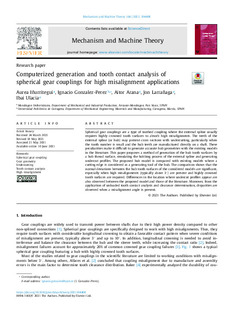Title
Computerized generation and tooth contact analysis of spherical gear couplings for high misalignment applicationsAuthor (from another institution)
Publication Date
2021Other institutions
Universidad Politécnica de CartagenaVersion
Published versionDocument type
Journal ArticleJournal ArticleLanguage
EnglishRights
© 2021 The AuthorsAccess
Open accessEmbargo end date
2023-10-31Publisher’s version
https://doi.org/10.1016/j.mechmachtheory.2021.104408Published at
Mechanism and Machine Theory Vol. 164. N. artículo 104408, 2021Publisher
Elsevier Ltd.Keywords
Spherical gear coupling
Gear geometry
Undercutting
Tooth contact analysis ... [+]
Gear geometry
Undercutting
Tooth contact analysis ... [+]
Spherical gear coupling
Gear geometry
Undercutting
Tooth contact analysis
High misalignment [-]
Gear geometry
Undercutting
Tooth contact analysis
High misalignment [-]
Abstract
Spherical gear couplings are a type of toothed coupling where the external spline usually requires highly crowned tooth surfaces to absorb high misalignments. The teeth of the external spline (or hub) ... [+]
Spherical gear couplings are a type of toothed coupling where the external spline usually requires highly crowned tooth surfaces to absorb high misalignments. The teeth of the external spline (or hub) may present cross sections with undercutting, particularly when the tooth number is small and the hub teeth are manufactured directly on a shaft. These peculiarities make it difficult to generate accurate hub geometries with the existing models in the literature. This paper proposes a method of generation of the hub tooth surfaces by a hob thread surface, simulating the hobbing process of the external spline and generating undercut profiles. The proposed hub model is compared with existing models where a cutting edge is considered as a generating tool of the hub. The comparison shows that the normal deviations between the hub tooth surfaces of the considered models are significant, especially when high misalignments (typically above 3 ◦) are present and highly crowned tooth surfaces are required. Differences in the location where undercut profiles appear are also observed between the proposed model and those of the literature. Moreover, from the application of unloaded tooth contact analysis and clearance determination, disparities are observed when a misalignment angle is present. [-]
Collections
- Articles - Engineering [758]
The following license files are associated with this item:






















